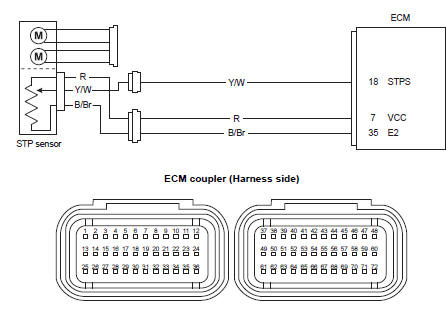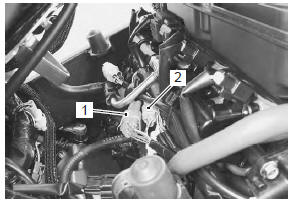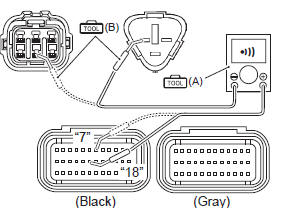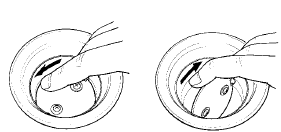Suzuki GSX-R 1000 Service Manual: DTC “c29” (p1654-h/l): secondary throttle position sensor (stps) circuit malfunction
Detected condition and possible cause
|
Detected condition |
Possible cause |
||
| C29 | Output voltage is not within the following
range. Difference between actual throttle opening and opening calculated by ecm is larger than specified value. 0.15 V ≤ Sensor voltage < 4.85 V |
|
|
| P1654 | H | Sensor voltage is higher than specified value. | |
| L | Sensor voltage is lower than specified value. | ||
Wiring diagram

Troubleshooting
| Caution when using the multi-circuit tester, do not strongly touch the terminal of the ecm coupler with a needle pointed tester probe to prevent terminal damage. |
| Note after repairing the trouble, clear the dtc using sds tool. Refer to “use of sds diagnosis reset procedures” . |
C29 (use of mode select switch)
|
Step |
Action |
Yes |
No |
|
1 |
Special tool Tester knob indication
voltage ( Stp sensor input voltage 4.5 – 5.5 V ((+) terminal: r – (–) terminal: ground, (+) terminal: r – (–) terminal: b/br)
Is the voltage ok? |
Go to step 3. |
|
P1654-h (use of sds)
|
Step |
Action |
Yes |
No |
|
1 |
Special tool Tester knob indication
continuity (
Special tool
(a):
(b):
Tester knob indication
continuity test ( Ecm couplers (harness side)
Is the continuity ok? |
Go to step 3. | Y/w wire shorted to vcc, or b/br wire open. |
P1654-l (use of sds)
|
Step |
Action |
Yes |
No |
|
1 |
Special tool Tester knob indication
continuity test (
Special tool Tester knob indication
continuity test ( Ecm couplers (harness side)
Is the continuity ok? |
Go to step 2. | R or y/w wire open, or y/w wire shorted to ground. |
|
2 |
Special tool
Tester knob indication
voltage ( Stp sensor input voltage 4.5 – 5.5 V ((+) terminal: r – (–) terminal: ground, (+) terminal: r – (–) terminal: b/br)
Is the voltage ok? |
Go to step 3. | Open or short circuit in the r or b/br wire. |
|
3 |
Special tool Tester knob indication
voltage ( Stp sensor output voltage secondary throttle valve is closed: approx. 0.7 V secondary throttle valve is opened: approx. 4.1 V ((+) terminal: y/w – (–) terminal: b/br)
Is the voltage ok? |
|
If check result is not satisfactory, replace the stp sensor with a new one. Refer to “stp sensor removal and installation” in section 1c . |
 DTC “c28” (p1655): secondary throttle
valve actuator (stva) malfunction
DTC “c28” (p1655): secondary throttle
valve actuator (stva) malfunction
Detected condition and possible cause
Detected condition
Possible cause
The operation voltage does not reach the stva.
Ecm does not receive communication signal from the ...
 DTC “c31” (p0705): gp switch circuit
malfunction
DTC “c31” (p0705): gp switch circuit
malfunction
Detected condition and possible cause
Detected condition
Possible cause
No gear position switch voltage
Gp switch voltage is not within the following range.
Gp switch ...
Other materials:
Tampering with noise control system prohibited
Federal law prohibits the following
acts or the causing there of;
The removal or rendering inoperative
by any person other
than for purposes of maintenance,
repair, or replacement,
of any device or element of
·design incorporated into any
new vehicle for the purpose of
noise ...
Corrosion prevention
It is important to take good care of
your motorcycle to protect it from
corrosion and keep it looking new
for years to come.
Important information about
corrosion
Common causes of corrosion
Accumulation of road salt, dirt,
moisture, or chemicals in hardto-
reach areas.
Chipping ...
Excva removal and installation
Removal
Turn the ignition switch off.
Remove the left side cowling. Refer to “exterior parts removal and
installation” in section 9d .
Connect the special tool (mode select switch) to the dealer mode
coupler. Refer to “self-diagnostic procedures” in section 1a .
After tur ...


 (a): 09900–25008 (multi
(a): 09900–25008 (multi
 )
)

 (a): 09900–25008 (multi
(a): 09900–25008 (multi
 )
)




 )
)


